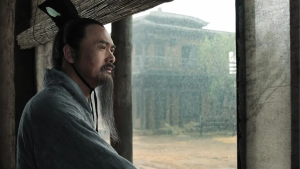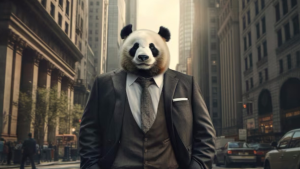Why the Chinese Dissatisfied with Black Myth: Wukong
I don’t believe that “Black Myth: Wukong” needs to remain 100% faithful to the original “Journey to the West.” Wukong falling in love with a demon, betraying his friends, surrendering to Heaven, or even getting his fellow monkeys killed – none of these scenarios bother me. But why did Wukong, as a background character in “Black Myth,” stir up so much controversy? It’s because “Black Myth” lacks well-rounded characters and a coherent story. Therefore, I think it’s necessary to review the history of Wukong’s evolving image.
In the late Qing Dynasty, intellectuals reimagined Wukong in humorous novels, bringing him into Qing-ruled China – riding trams, visiting nude art exhibitions, and even smoking opium. These portrayals reflected their confusion and trauma under imperialist and colonial capitalist modernization.
During the War of Resistance Against Japan, Wukong was once again “transmitted” to the era of Resistance, defeating Japanese invaders, winning Olympic gold medals, and traveling to Mars, where he encountered a utopian worldview of unity among Martians. These portrayals reflected intellectuals’ exploration of both Chinese nationalism and internationalism.

These depictions of Wukong served as metaphors for intellectuals’ aspirations. However, the Wukong that became widely accepted by the public in our times emerged during the establishment of the People’s Republic of China.
Some purists of the original “Journey to the West” emphasize a divide between the rebellious “Great Sage Equaling Heaven” and the “Victorious Fighting Buddha” who achieves enlightenment. So they patch this divide by transferring Wukong’s journey into a story of growth and self-transcendence. However, a more materialistic viewpoint suggests that these two identities represent the people’s struggle against imperial power and the traditional values of loyalty and filial piety, coexisting in contradiction and forming the ideological core of “Journey to the West.”
In fact, imperialist and reactionary rulers had also long recognized Wukong as a symbol of rebellion.
According to “Xiaoting Xulu,” Emperor Qianlong of the Qing dynasty ordered Zhang Wenmin to produce a performance, “The Peaceful Raft of Ascension,” depicting the Journey to the West. The script, written by Zhang, was crafted to uphold the idea of “domestic peace,” using the play to reinforce the Qing dynasty’s rule. After Wukong’s defeat by Buddha, the creators added a celebratory scene titled “Taming the Greedy Tiger and Bringing Peace to Heaven.” Wukong, referred to as “the Greedy Tiger,” was portrayed as the disruptive force and enemy of the Qing’s order. The theme of “suppressing the rebellious” ran throughout.
After the Qing dynasty collapsed in 1912, the warlord-ruled Beiyang government similarly attempted to mimic this play in their production of “New Peace in Heaven.” In 1915, for Yuan Shikai’s 57th birthday, “New Peace in Heaven” was performed, portraying Wukong’s defeat while mocking the revolutionaries like Sun Yat-sen and Huang Xing, symbolizing the failure of China’s Second Revolution.
Clearly, both the Qing Dynasty and the Beiyang government recognized that Wukong wasn’t a servant to their regimes, so they sought to emasculate and demonize him culturally.
In contrast, the narrative of Wukong in the era of the People’s Republic flipped history on its head. In “The Triumph Song” from the 1956 Peking Opera “Havoc in Heaven,” the lines wrote:
“The decayed Heavenly Palace is just for show, under the weight of the Golden Staff it crumbles.”
“Celestial generals flee, celestial soldiers scatter. The victory song echoes through the Flower and Fruit Mountain!”
The Wukong who had been suppressed in “The Peace in Heaven” rises up and becomes the master in “Havoc in Heaven,” merging with the tides of social changes.

To emphasize the people’s role in the 1956 Peking Opera “Havoc in Heaven,” Premier Zhou Enlai gave specific instructions, including depicting Wukong defeating the Heavenly Joy Star, a character representing the ruling intellectual class, with simple wit and riddles.
This echoed Mao Zedong’s comments on new and revolutionary operas, such as “Forced to Mount Liang,” which sought to restore history’s true face by overturning the past depictions where the people were sidelined and ruled by the elites:
“History is created by the people, but on the stage of old operas (and in all old literature and old art that have been removed from the people), the people became mere dregs, while the stage was dominated by lords, ladies, young masters, and young mistresses. This reversal of history has now been overturned by you, restoring the true face of history, and thus giving the old opera a new lease on life. This is worth celebrating.”
Mao’s famous line, “The golden monkey wields its mighty staff, sweeping away the dust in the jade sky,” wasn’t merely about advocating for struggle but went a step further.
This poem, “Seven-Character Verse: In Response to Comrade Guo Moruo,” essentially revolves around a debate about the Shaoxing opera “Sun Wukong’s Three Battles with the White Bone Demon.” Guo Moruo criticized the character of Tang Sanzang in the play, stating “Tang’s flesh deserves a thousand cuts,” while Mao Zedong believed, “The monk may be a fool, but can still be taught; the demon, however, will surely wreak havoc.” In essence, the conflict between Sun Wukong and Tang Sanzang is an internal conflict among the people, whereas the demon represents a clear enemy.
Thus, it can be said that “Havoc in Heaven” reflects the New Democratic Revolution period’s breaking away from old traditions, while “The Three Battles with the White Bone Demon” addresses how to resolve conflicts with Tang Sanzang and recognize the “White Bone Demon” during the Socialist construction period.
During the Cultural Revolution, despite the radical rejection of traditional monkey plays due to their feudal elements, the image of Sun Wukong as a fighter continued to deepen and evolve.
In the 1980s, Sun Wukong’s image underwent another transformation with the winds of reform. The most iconic symbol of this period is the 1986 version of the TV series “Journey to the West.” This adaptation not only influenced several generations of Chinese people but also deeply ingrained the character of Sun Wukong into the public consciousness.
In the 1986 TV series “Journey to the West,” Sun Wukong is portrayed as a figure who battles demons and monsters throughout the journey and ultimately attains enlightenment. However, this portrayal does not completely negate the image of the Great Sage who caused havoc in Heaven. Instead, it provides a more rational motivation for his actions compared to the original book.
Similarly, the 1986 TV adaptation of “Journey to the West” reflects the intellectual spirit of the reform and opening-up era. The theme of the TV series “Dare to Ask Where the Road Lies” resonates with China’s reform and opening-up policy of “crossing the river by touching the stones,” but also reflects hesitations about the uncertain future. On the other hand, the production team traveled across China to film and used upward camera angles to capture the westward travelers, thereby blending the nationalism conveyed by the magnificent landscapes with the heroism expressed through the filming perspective, ultimately conveying a confidence that is undaunted by future challenges.
As the lyrics say: “Dare to ask where the road lies, the road is underfoot.” This sentiment reflects the mindset of intellectuals in the early to mid-1980s.

However, as China’s market economy surged, the spirit of the 1980s combining with uncertainty and confidence began to fade, replaced by the decadent “scar literature” of the likes of “A Chinese Odyssey” and “Wukong Biography,” signaling the “death” of Wukong as a hero.
The precursor to this transition is Li Feng’s “Another Voice.” In this work, the journey to the West is defined as a “meaningless trip,” and Sun Wukong loses his memory due to a series of mishaps, traveling through time and space to become a courtesan in the Southern Song Dynasty and a maid of Wu Cheng’en. When Sun Wukong finally regains his memory and exits history, he is captured by the US dollar, loses his tail, and becomes a “human”—a metaphor for bidding farewell to history and embracing globalization.
In the comedy film “A Chinese Odyssey,” Zhi Zun Bao transforms back into Sun Wukong to continue his enlightenment, as though still perceived as a hero. However, the line “he seems like a dog” reflects a liberal and humanistic value judgment: a hero stripped of “love” cannot be regarded as truly “human.” This value judgment is still evident in current criticisms of so-called “asceticism” and “saintly themes.” This also explains why many contemporary screenwriters in China struggle to create stories without a love element.
On the other hand, the spiritual predecessor of “Black Myth: Wukong,” “The Legend of Wukong,” more explicitly rejects the significance of the journey to the West. It returns Sun Wukong to his second havoc in Heaven, despite nothing changing at the end. On the surface, Sun Wukong in “The Legend of Wukong” seems to share similarities with the same rebellious figure, but it is essentially a “rebellious teenager” story.
The author of “The Legend of Wukong” explains his philosophy as follows:
“In my view, ‘Journey to the West’ is the path of human life. Everyone has their own journey to the West; we are all moving westward, and when we reach the West, everything becomes void, returning to the origin. Everyone inevitably heads toward this end; you cannot choose or turn back. So, what should you do? You can only strive to make the journey as splendid as possible, to walk with your head held high, to experience more, think more, see more, and do what you want to do. In the end, you should be able to say, ‘I have been in this world, I have loved, I have fought, and I do not regret it.’”
In this context, the political and social Sun Wukong has transformed into a personal, subcultural Sun Wukong, becoming a symbol in teenager literature and an annotation of fatalism and nihilism. This ideological influence gave rise to the first video game “Asura” developed by the original team of the Game Science. And eventually, all of these elements led to its “Black Myth: Wukong.”

In conclusion, Wukong’s image is not confined to the original “Journey to the West” book, but has evolved with the times and reflected historical changes. In this sense, telling Wukong’s story is to narrate the story of the times.
“Black Myth: Wukong,” with its Unreal Engine 5 graphics and support from local tourism departments, was poised to leave a significant mark in this era, contributing to the ongoing evolution of Wukong’s image. Yet, with the narrative falling short, Wukong’s portrayal has become problematic.
Before its release, many dreamed of retracing the steps of “Journey to the West,” role-playing the hero Wukong of their times, and introducing Chinese mythology to the world. But after its release, we have only witnessed players searching desperately in the game for another alternate ending. And the fans of the “Black Myth” can only gloss over the narrative shortcomings by boasting the game’s sales and overwhelming positive ratings. All of these just highlight how significant the story issues were.
https://www.zhihu.com/question/665560621/answer/3614985798




